Vortex is now in its third incarnation of a handgun optic. The first two are now rather old school in a modern pistol red dot world, and with their newest model, Vortex has made things a little more compact. The Vortex Defender-CCW red dot sight is their latest. It’s a small pistol optic with some modern flair and appeal. With the Defender-CCW, Vortex aims to provide a basic, but a durable and, most importantly, reasonably priced red dot sight for concealed carry.
The popular Shield RMSc footprint is becoming nearly universal among subcompact pistols and even on some larger models and that’s what Vortex chose for the Defender-CCW. Out of the box, the sight impressed me.
Well, what was in the box impressed me. For a budget optic, I didn’t expect a Picatinny mount or a series of screws to make attachment easy, but that’s what I found. Vortex includes half a dozen different screw sizes to make it easy to attach the sight to whatever handgun you may have.
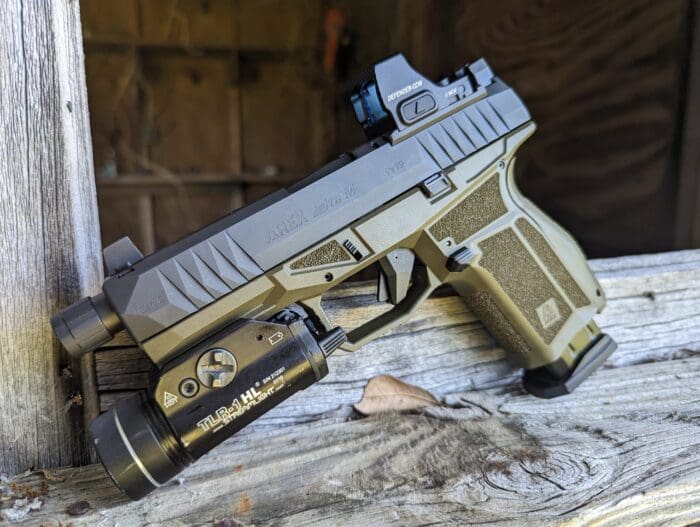
Along with those screws and the adapter, there’s also a shim plate and a handy little tool to attach the optic, replace the battery, and zero it. I’m a sucker for little tools like that.
I’ve already said it’s an affordably priced optic, but how affordable? The MSRP is $349.99, but when they first premiered, they seemed to be selling for $249. Lately I’ve been seeing I’m seeing them priced close to $200 if you look hard. That almost seems too good to be true for an optic designed for serious use. Let’s dig in and see if the optic is worth it.
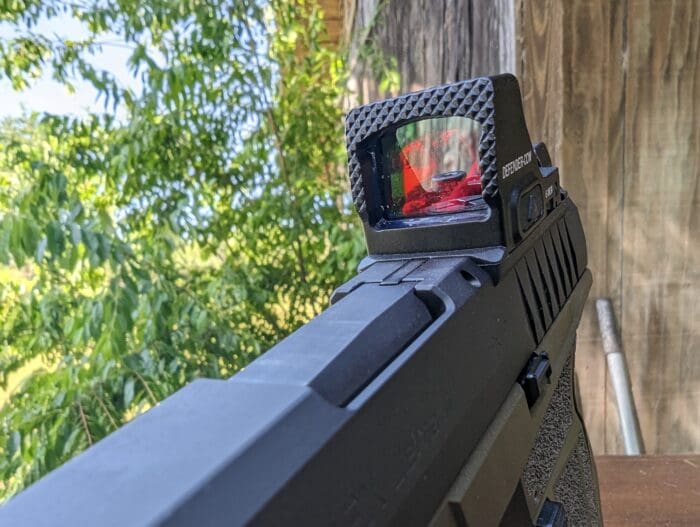
Vortex Defender-CCW Specifications and Features
The Defender-CCW is a featherweight at .95 of an ounce, and it’s only 1.59 inches long and the little guy is made from 7075 aluminum. Vortex says they use polymer inserts to help absorb shock and improve durability. It seems like a good idea, but we’ll figure that out soon enough.

Shooters can choose between a 3 or 6 MOA dot. I went with the more eye-catching 6 MOA option. There are ten brightness settings along with two-night vision settings.
Battery life is rated at a measly 9,000 hours. That’s just over a year in a category where competitors are getting a minimum of 20,000 hours and as much as 50,000 of rated use. That probably has something to do with Vortex’s decision to power the Defender-CCW with a CR1632 battery rather than the more frequently used, higher capacity CR2032.
Vortex has given the Defender-CCW shake-awake technology. That’s nice, but the optic doesn’t auto shut-off until it hasn’t been touched for 14 hours. Think about that. If this is the red dot you mount on your EDC, as it’s being marketed, and it’s on your hip for most of the day, a 14-hour shut-down time means the Defender-CCW will virtually never turn itself off.
That’s OK if you’re getting at least 20,000 hours — about 2½ years — of battery life. But that isn’t the case here. The Defender-CCW gives you less than half that. Perhaps a more powerful battery, and/or a shorter auto shut-off time to conserve more power would have been a better way to go.
Again, other red dots in the same price range, some without shake-awake, will give you 50,000 hours of run time. Besides, shake-awake doesn’t get you much if you won’t have to change your battery for well over five years anyway.
The good news is swapping out the CR1632 battery is a breeze, no matter how often you need to do it, thanks to the top-loading design. Very convenient and easy.
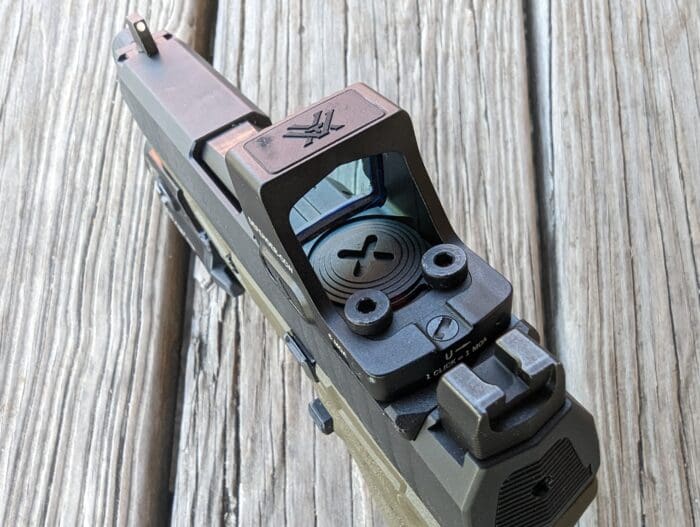
One of the Defender-CCW’s more noticeable features is the prominently textured front frame. This is supposed to allow for easier cocking of the slide using a belt, a wall, a table, whatever. Of course, you can do that with practically any optic, but Vortex’s texturing is supposed to help make sure the sight gives you a good grip. To me, it’s also the company endorsing a behavior that I will happily indulge in.
Controls and Zeroing
The Defender-CCW’s controls consist of two big prominent buttons on either side of the housing. They control brightness levels, as well as turning the optic on and off. They’re nicely sized, easy to access, and recessed slightly, which is a nice touch. That helps prevent accidental presses.
It takes some real effort to press the buttons and to change the brightness levels, which is a good thing. That, along with the recessing means you won’t accidentally change your brightness level. They’re easy to use and control, and the buttons have a good tactile feel to them.

Zeroing isn’t difficult, but Vortex seemed shy about making windage and elevation adjustments tactile. They’s just enough of a click to barely feel it as you make adjustments, one MOA at a time. You really have to pay attention to the slight rotations you are making.
At the Range
That big 6 MOA dot is easy to see, but it’s not super crisp or round. It also tends to starburst a bit unless you crank it up to the highest settings. If you max out the brightness level, it’s quite clear and crisp, and easy to see in the daylight. The dot contrasts well against the blue tint of the glass, which isn’t severe, (though it’s noticeable).
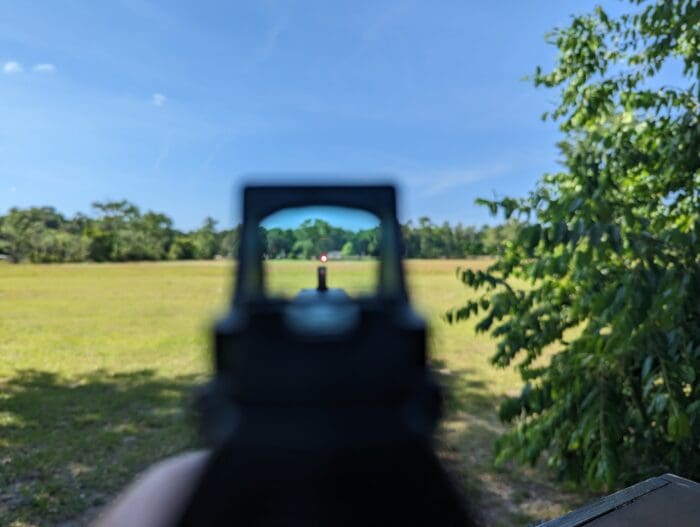
Also, the red dot flickers slightly and lags a bit when rapidly moved. The flicker is most noticeable at lower brightness levels and goes away when the red dot is set to maximum brightness.
If you drive the gun from target to target, you’ll notice it trailing a bit. The flicker and lag are no doubt due to a low refresh rate. That may not bother everyone, but if you have a keen eye and can track your dot, you might notice it as the slide reciprocates as well.
Is that bad? Probably not for most shooters. Still, it’s noticeable and a telltale sign of a budget optic.
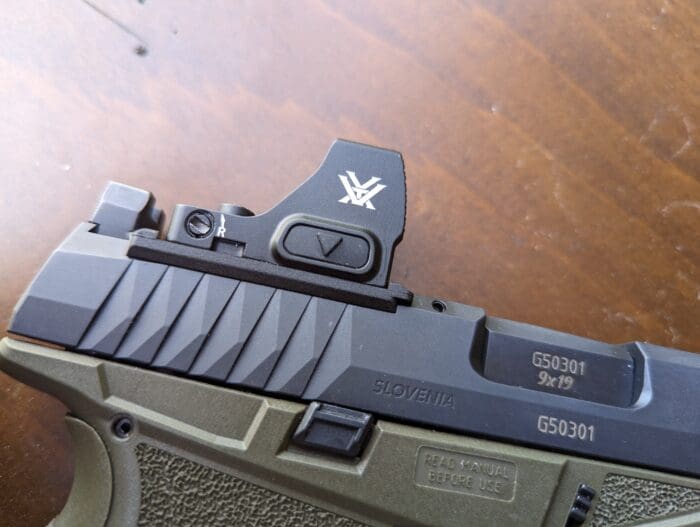
The dot holds zero well, and through several hundred rounds it didn’t lose or slip its zero. The dot shows up perfectly with ambient light coming from the rear, the front, or sides. Used with a weapon light, it’s quite visible and shows up without issue.
The Vortex Defender-CCW seemed to be fairly solid at the range, so I figured…let’s beat it up.
Drops, Falls, and Water
First, I slammed the front of the Defender-CCW into a table and a wall and my boot, Mad Max style. I did it over and over again and the lens remained in place. The optic didn’t loosen at all. After some slamming, I did a few chest-high drops onto the range floor immediately after I got to the range and let the lead fly.
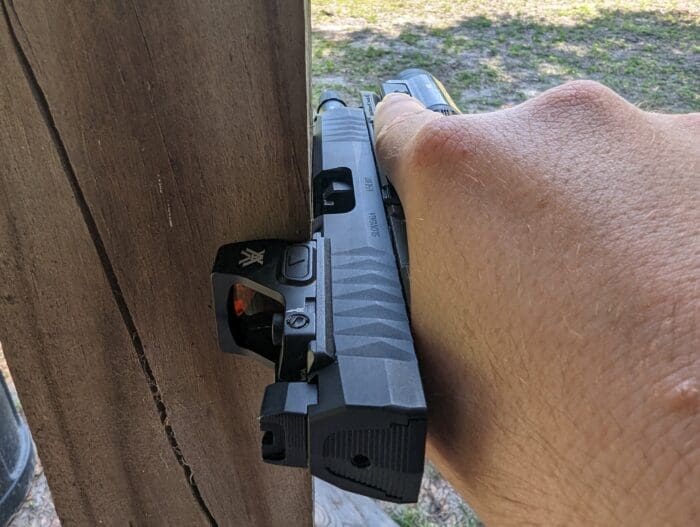
There was no zero shift, and the optic still worked without issue. The Vortex Defender-CCW held up well. To test the waterproof nature of the optic, I sprayed it with a hose, and again, I had zero failures due to water.
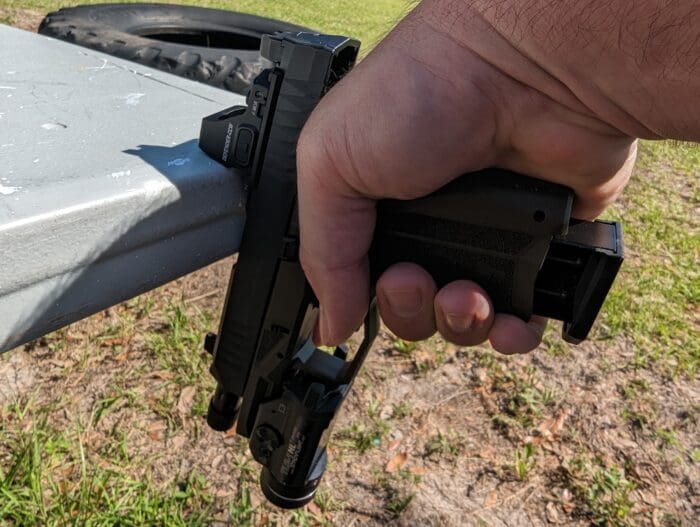
Given the bangs and knocks the Defender-CCW is likely to get mounted to an everyday carry pistol, that’s good performance. For the relatively affordable price point, it seems more than durable enough for concealed carry use.
Specifications: Vortex Defender-CCW Red Dot Sight
Mount: Shield RMS/RMSc
Magnification: 1X
Dot Size: 3 or 6 MOA
Click Adjustments: 1 MOA
Max Windage Adjustments: 105 MOA
Max Elevation Adjustments: 110 MOA
Length: 1.59″
Weight: .95 oz.
MSRP: $349.99 (about $250 retail)
Ratings (out of five stars)
Clarity: * * *
The dot is clear at the highest level, but not perfect at anything lower. There’s a faint flicker and is lags when moved quickly. The lens has slightly blue tinge, but that’s not a real problem.
Ergonomics: * * * *
The Defender-CCW is small, lightweight, and easily to mount and use. The buttons are great, as is the battery placement. The super-light windage and elevation adjustments aren’t ideal.
Reliability: * * * * *
No complaints here. It takes a decent beating and functions well.
Overall: * * ½
The big issues here are the dot flicker and lag. The battery life is also notably low. The auto shut-off time and shake awake make no sense. Some strange choices were made in this sight’s design process. The Defender-CCW isn’t fancy or groundbreaking, but it’s one of the better built models in the more affordable class of red dots on the market. For less than about $250, the Vortex Defender-CCW works, but it’s not a standout at that price.


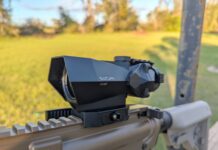


overall.. Meh! Nothing great or innovative, not impressive. Same old thing that others have done better.
Yawn.
An important dimension was missing: Width.
Seems more like interest is missing. No disrespect to the author. I guess he reviews what he’s assigned to review. It’s that SIG always meant top of the line to me. This does not strike me as such.
This isn’t a SIG sight. It’s from Vortex.
I guess I should qualify that last comment. I wouldn’t have an optic on a carry handgun on a bet. Yes, I’ve used them.
Vortex.
You ever see snow geese over a green wheat field?
And some of the young ones turn sideways and slip stream through the middle.
There are superior options in this price range.
Vortex missed the mark by a mile with this one. It’s like they just unveiled an optic in 2013.
This Red Dot Sight is very tactical, I try it once in shooting range and it work pretty fine.
how does a rating of 3, 4, and a 5 get an overall of 2.5?
Comments are closed.